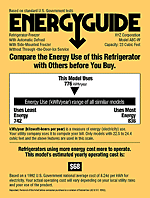Power plants and climate change have been on the minds of many consumers who lost electrical service and sweated out the record-breaking temperatures that recently hit areas across the country. Most experts believe the planet’s temperature has been rising as a result of increasing amounts of carbon dioxide and other greenhouse gases in the atmosphere, helping to cause extreme weather patterns around the globe.
Energy use in homes contributes significantly to the problem. According to the American Council for an Energy-Efficient Economy, home energy use is responsible for one-sixth of greenhouse gas emissions in the U.S. While space heating accounts for the majority of total home energy use, appliances come in a close second, followed by water heating and air conditioning.
Pushed by consumer demand, efficiency standards, and energy labeling, manufacturers have made a number of their products more efficient in recent years. Many consumers rate energy consumption high among the factors that drive their purchasing decisions for larger home appliances. So with all these improvements, you may wonder why Americans still consume more total energy in homes and commercial buildings than any other country — including China, which has four times as many people.
According to the federal government’s Energy Information Agency, it’s because the size of our homes and the number and size of the energy-consuming appliances we use continue to increase. Although many consumer products are more efficient than ever, this isn’t enough to compensate for the increased demand for energy that comes with bigger houses and more energy-dependent goods. Some experts anticipate that the electricity used by a proliferating number of small appliances and electronic products — like cordless tools, computers, and security systems — could account for nearly half of the electricity consumption in American households by 2015, up from 30 percent today.
The challenge for consumers is to find and choose the most energy-efficient models when purchasing new equipment, and to learn about all the things they can do to make their home and existing equipment operate as efficiently as possible. Here are a few tips for the big-ticket items in your household. But don’t stop there. A multitude of additional tools and references are easily accessible, and financing is sometimes available to make energy-efficient technology even more affordable. Some particularly helpful websites are listed at the end of this article.

When shopping for new appliances, look for Energy Guide labels, big, yellow stickers that the federal government requires manufacturers to put on major home appliances. The labels show how a particular model’s energy consumption compares to other similar models, including the most efficient one. The stickers are invaluable in helping consumers factor energy consumption into their purchasing decisions. However, if you are comparing different types of machines — such as a front-loading and a top-loading washer — be sure to focus on the total energy consumption (in kilowatt hours) since the labels only compare similar designs.
You should also consider the difference in size or capacity of the machines you are comparing and the impact on energy consumption. For example, a smaller capacity washing machine may consume less energy per load. But if you have to do twice as many loads to clean the same amount of laundry, the smaller machine may end up using more energy overall than a larger machine.
Also, watch for the Energy Star logo, which is featured on products that are more efficient than other models in their class, according to standards set by the Department of Energy and the EPA.
If you’re buying a new furnace or central air-conditioning system, make sure the contractor estimates the annual operating costs for the different models appropriate for your home. Compare these costs to the purchase and installation price, along with other features. The efficiency of both heating and cooling systems depends heavily on having the right size unit. Systems that are too big can be just as inefficient as those that are too small.
How you operate the system is also critical. Programmable thermostats can help you save energy by automatically turning your thermostat up (in summer) or down (in winter) during times when you are away from home or asleep. Finding and blocking the sources of unwanted heat gain and loss can be time-consuming, but it’s an important task that is often well worth the effort. Sealing cracks, seams, and other openings in walls and ceilings and around windows and doors can make your home more comfortable, in addition to saving money and energy.
Compact fluorescents (CFLs), those funny-looking, highly efficient bulbs, have markedly improved in recent years. In fact, our testers couldn’t tell the difference between the quality of light from the better CFLs and from conventional incandescents. While they still cost more than incandescents at the checkout, they should last much longer and you’ll recoup the extra cost and more in avoided energy costs over the life of the bulb. The federal government estimates that if every household replaced its most heavily used incandescents with compact fluorescents, it would cut annual energy use by 32 billion kilowatt hours, saving consumers a total of about $2.6 billion. The bulbs we recommend include Osram Sylvania CF 30 EL/C/830/MED/6, General Electric FLE28QBX/SPX27, and Philips Earth Lite (which is also available in a dimmable model).
More information on compact fluorescents is available in the January 1999 issue of Consumer Reports magazine. For more guidance on buying central cooling and heating systems, see articles in the June 1998 and October 1998 issues.
For detailed information and interactive software programs to help make your home operate more efficiently, visit the websites of the DOE’s Energy Efficiency and Renewable Energy Network (phone 1.800.363.3732) and the American Council for an Energy-Efficient Economy (phone 202.429.8873).

